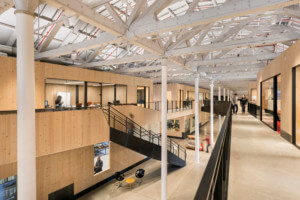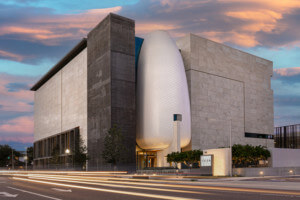It takes a brave firm—and in St. Petersburg, Florida, two brave firms—to work on a project from which West 8, BIG, and Michael Maltzan were roundly rejected.
For almost a century, the City of St. Petersburg’s pier, in various incarnations, has attracted residents and tourists to Tampa Bay. Once a fishing pier, amenities were added over time: An inverted pyramid-cum-restaurant from the 1970s, reviled at first, later became a local icon. By the late 2000s, however, the pier was deemed structurally unsound and the city moved to demolish and replace the structure via a national competition.
The competition jury originally selected Los Angeles–based Michael Maltzan to redesign the pier in 2012. His bid followed the program of the original pier closely, with an event space at the terminus that referenced the iconic pyramid. Then, a group of residents organized a public referendum against the plan, claiming it did not meet the needs of the city. A little over a year and $5 million in, the city withdrew its invitation to the firm.
The setback exposed deeper questions about the relationship between the city and its beloved pier. City architect Raul Quintana praised Maltzan’s practice and noted that the plan was “ahead of its time.” The city, though, had to reckon with its heritage before it could embrace other possibilities for the pier. Quintana clarified that, even when presented with broader programs, the community still read the pier as a linear typology, though he felt that the consensus to build a quality public space was emerging. “The values today have changed. Think about what a pier could be for the 21st century. It was very, very difficult at first to get people to change their thinking.”
In 2015 New York–based architecture firm Rogers Partners won a reissued competition with its proposal for a 13-acre armature that nixes the cool-object-far-from-shore model of the old pier in favor of the pier as a premier public space and natural extension of the waterfront. “The idea of a major public expenditure to build a site for a retail destination is not really how you think about the public realm in the 21st century,” Rob Rogers, founding principal, explained. “The underpinning of our idea is that the city’s waterfront, including the pier, is all public park space.”
In collaboration with New York–based landscape architecture firm Ken Smith Workshop, the firm looked to Chicago’s Navy and L.A.’s Santa Monica piers for design and program ideas, but created opportunities in St. Petersburg for engaging with the bay-scape with programming that exceeds that of a traditional fishing or amusement pier: A one-acre coastal thicket, “a tray of landscape over the water,” provides shade and slopes close to the bay, while an outdoor educational space adjacent to a 300-foot artificial reef and naturalized beach brings people in contact with native aquatic flora and fauna. Boating and fishing facilities, hemmed by floating docks, flank traditional wide promenades, and a shallow saltwater pool next to the signature end-of-pier restaurant lets patrons cool their feet while drinking cocktails. A sloping grass lawn can accommodate between four and five thousand people for concerts, while a trolley and bike paths offer easy access to the mainland. Tampa–based ASD is the executive architect on the project.
It was crucial, Rogers elaborated, that programming created an array of nonlinear nodes, so that someone’s fifth or fiftieth visit to the pier would prove as exciting as the first. This time, the community is on board: At the most recent public meeting, the organization that opposed Maltzan’s pier plan came out in strong support of the new design.
Just as Athens’s acropolis is graced by propylaea, the St. Petersburg pier is nothing without its “pier approach.” W Architecture & Landscape Architecture entered the same competition as Rogers Partners, but didn’t get the initial commission. Several months later, founding principal Barbara Wilks explained, the city sent a second RFP to the firm that asked for the “pier approach,” a design for the upland section and the infill spit that leads up to the new pier. Part of the reason for the split, city development director Chris Ballestra elaborated, was that the city hadn’t secured the money for the approach when they hired Rogers. Although W’s work builds on a previous masterplan by AECOM, W is collaborating with Rogers to unify the material palette and to knit the two plans closely with downtown St. Petersburg.
W’s concept phase wraps next month and the project will move onto design, while Rogers Partners’ pier is in design development. Construction on the pier and the approach is expected to be complete by 2018.










